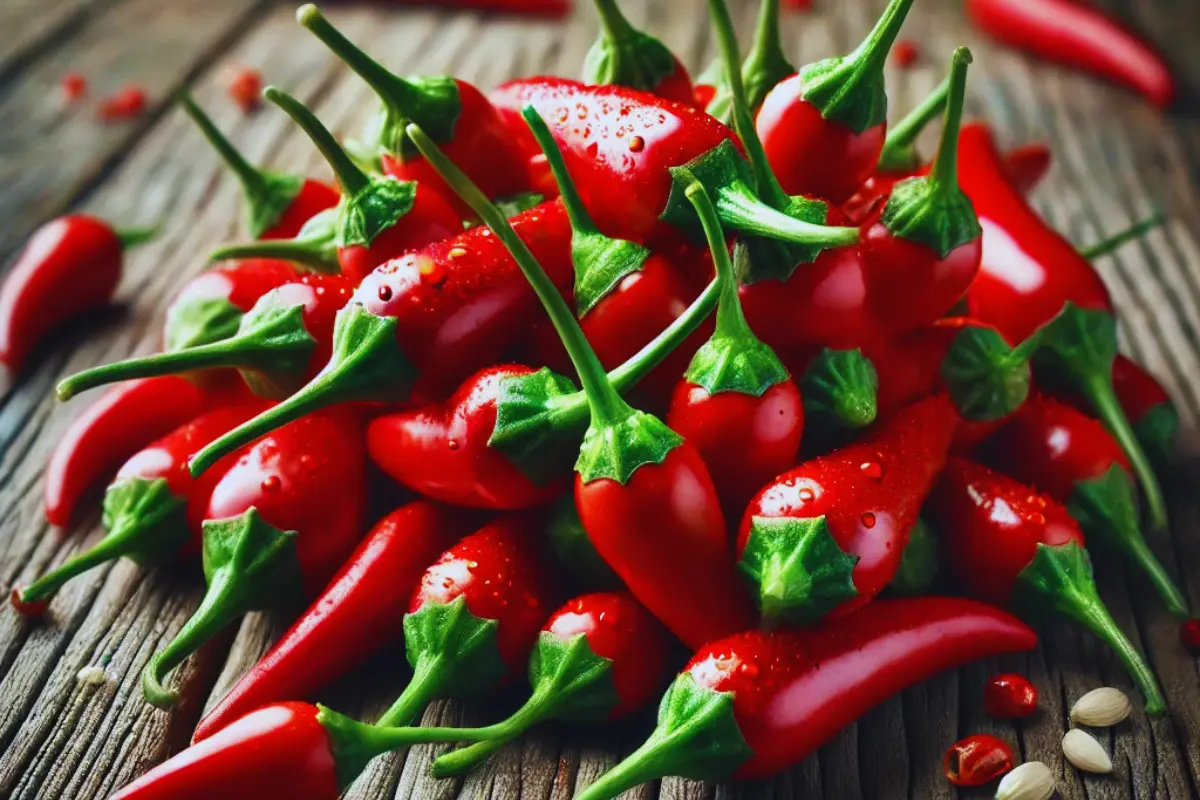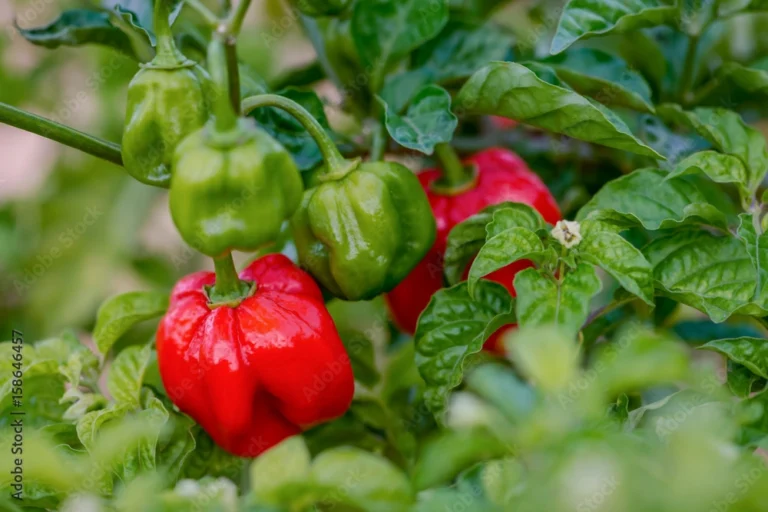Bird’s Eye Chili: Heat, Flavor, and Uses
How hot are bird’s eye chillis?
Thai Bird’s Eye Chili, known for its intense heat and distinctive flavor, is a staple ingredient in Thai and Southeast Asian cuisine. It’s often referred to as “Prik Kee Noo” in Thai, which loosely translates to “mouse droppings chili” due to its tiny size. Don’t let the name fool you—this chili packs a serious punch. In this detailed guide, we’ll explore everything you need to know about Thai Bird’s Eye chili, from its heat level and culinary uses to its health benefits and how to grow your own. Plus, we’ll provide helpful comparisons with other popular chili varieties and tips on how to buy, store, and use them effectively.

Heat Level of Thai Bird’s Eye Chili
The heat of a chili is measured in Scoville Heat Units (SHU), and Thai Bird’s Eye chili ranges from 50,000 to 100,000 SHU. This places it firmly in the “hot” category of chilies, significantly spicier than Jalapeños (2,500 to 8,000 SHU) but less intense than Habaneros (100,000 to 350,000 SHU) or Ghost Peppers (over 1 million SHU). Despite its small size, Thai Bird’s Eye chili brings a sharp, immediate heat that can quickly dominate a dish.
Flavor Profile
Thai Bird’s Eye chili offers more than just heat. Its flavor profile includes subtle fruity and citrusy notes that complement the spiciness. This combination makes it ideal for a wide variety of dishes, providing a fiery kick without overwhelming the other ingredients.
Culinary Uses of Thai Bird’s Eye Chili
One of the reasons Thai Bird’s Eye chili is so popular is its versatility in cooking. It is a key ingredient in numerous Thai and Southeast Asian recipes. Below are some common ways to use this chili in cooking:
Curries: Thai Bird’s Eye chilies are essential in making traditional Thai curry pastes. They provide the heat that balances the richness of coconut milk in dishes like Thai Green Curry and Red Curry.
Tom Yum Soup: This iconic hot and sour soup wouldn’t be the same without the addition of Bird’s Eye chilies. They give the soup its signature spiciness that pairs perfectly with the sourness of lime and the umami of fish sauce.
Som Tum (Green Papaya Salad): This refreshing salad incorporates raw Bird’s Eye chilies, giving it a spicy kick that contrasts beautifully with the crunchy green papaya, tangy lime juice, and salty fish sauce.
Stir-fries: Thai Bird’s Eye chili is frequently used in stir-fries like Pad Kra Pao (Thai basil chicken). The chilies are lightly crushed and sautéed with garlic and herbs to infuse the dish with heat and flavor.
Chili Pastes: Thai chili pastes, such as Nam Prik, often feature Bird’s Eye chilies as a core ingredient. These pastes can be used as condiments, dips, or seasonings for various dishes.
Dipping Sauces: Mixed with lime juice, fish sauce, and sugar, Bird’s Eye chilies make a fantastic dipping sauce for grilled meats, seafood, or fresh vegetables.
Health Benefits of Thai Bird’s Eye Chili
Beyond its culinary uses, Thai Bird’s Eye chili is packed with health benefits thanks to its high capsaicin content. Capsaicin is the compound responsible for the heat in chili peppers and offers several health benefits:
Boosts Metabolism: Capsaicin increases the body’s heat production (thermogenesis), which can help burn more calories and aid in weight loss.
Pain Relief: Capsaicin is known for its pain-relieving properties and is used in creams to treat conditions like arthritis and muscle pain. It works by desensitizing pain receptors in the skin.
Heart Health: Consuming spicy foods like Thai Bird’s Eye chili has been linked to improved cardiovascular health. Capsaicin may help lower cholesterol levels and reduce the risk of heart disease.
Rich in Antioxidants: Thai Bird’s Eye chili is an excellent source of antioxidants, such as vitamin C, which helps to protect cells from damage and supports immune function.
Anti-inflammatory Properties: Capsaicin also has anti-inflammatory effects, which can help reduce inflammation and alleviate symptoms of conditions like arthritis.
How to Grow Thai Bird’s Eye Chili
If you love fresh chilies, consider growing Thai Bird’s Eye chili at home. These plants are relatively easy to care for and can be grown both indoors and outdoors, depending on your climate.

How to Grow Thai Bird’s Eye Chili
If you love fresh chilies, consider growing Thai Bird’s Eye chili at home. These plants are relatively easy to care for and can be grown both indoors and outdoors, depending on your climate.
Climate and Sunlight: Thai Bird’s Eye chili plants thrive in warm, sunny climates. They require full sunlight for at least six hours a day and prefer temperatures between 70°F and 85°F.
Soil: These chilies grow best in well-drained, slightly acidic soil with a pH level of 6.0 to 6.5. Adding organic compost can improve soil fertility.
Watering: The plants need regular watering, but it’s essential not to overwater. Allow the top layer of soil to dry out between waterings to prevent root rot.
Fertilization: Use a balanced fertilizer rich in phosphorus and potassium to promote healthy growth and fruiting.
Harvesting: Bird’s Eye chilies start green and turn red when fully ripe. You can harvest them at either stage, but red chilies are typically hotter and more flavorful.
Comparing Thai Bird’s Eye Chili to Other Popular Chilies
Thai Bird’s Eye chili stands out for its intense heat and fruity flavor, but how does it compare to other commonly used peppers? Here’s a quick comparison:
Jalapeño: Jalapeños are much milder, with a Scoville rating of 2,500 to 8,000 SHU. They have a grassy, slightly sweet flavor and are used in Mexican and Tex-Mex dishes. While Jalapeños offer a gentle heat, Thai Bird’s Eye chili delivers a more intense, sharp burn.
Habanero: Habaneros are hotter than Thai Bird’s Eye chilies, ranging from 100,000 to 350,000 SHU. They have a fruity, almost tropical flavor that contrasts with the sharper heat of Bird’s Eye chilies. Habaneros are commonly used in Caribbean and Latin American cuisines.
Poblano: Poblanos are much milder, with a heat level of 1,000 to 2,000 SHU. They have an earthy, slightly smoky flavor and are often roasted and stuffed. Thai Bird’s Eye chilies are far spicier and are used to provide heat rather than mild warmth.
Ghost Pepper: At over 1 million SHU, Ghost Peppers are much hotter than Thai Bird’s Eye chili. Ghost Peppers are used sparingly due to their extreme heat, while Bird’s Eye chili offers a more balanced level of spiciness for everyday cooking.
Scotch Bonnet: Similar in heat to Habaneros, Scotch Bonnets have a Scoville rating of 100,000 to 350,000 SHU. They are popular in Caribbean dishes, adding tropical sweetness alongside intense heat. While Scotch Bonnets are sweeter, Bird’s Eye chilies bring a sharper, more immediate heat.
How to Buy and Store Thai Bird’s Eye Chili
Thai Bird’s Eye chilies are widely available in Asian grocery stores, specialty markets, and online retailers. They can be purchased fresh, dried, or as part of pre-made chili pastes. When buying fresh Bird’s Eye chilies, look for bright, firm peppers with smooth, shiny skin. Avoid peppers that are soft, wrinkled, or discolored.
Fresh Chilies: Store fresh Bird’s Eye chilies in the refrigerator. They can last for up to two weeks when stored in a sealed container or plastic bag.
Dried Chilies: Dried Bird’s Eye chilies should be stored in an airtight container in a cool, dark place. They can last for several months when stored properly.
Frozen Chilies: You can also freeze Bird’s Eye chilies to extend their shelf life. Simply wash and dry the chilies, then place them in a freezer-safe bag or container. Frozen chilies can last for up to a year.
Using Thai Bird’s Eye Chili in Your Cooking
Thai Bird’s Eye chilies can be used fresh, dried, or ground, depending on the recipe. Here are a few tips for incorporating them into your dishes:
Handling: Always wear gloves when handling Bird’s Eye chilies, especially when cutting or crushing them, as the capsaicin can irritate your skin.
Adjusting Heat: To reduce the heat, remove the seeds and membranes from the chilies before adding them to your dish. For maximum heat, use the entire chili, including the seeds.
Blending and Grinding: Fresh Bird’s Eye chilies can be blended into sauces or curries, while dried chilies can be ground into a powder to use as a seasoning.
Pickling: Pickled Bird’s Eye chilies make a delicious condiment and can be added to salads, sandwiches, or noodle dishes.
Conclusion
Thai Bird’s Eye chili is a fiery, versatile ingredient that has earned its place in the culinary traditions of Southeast Asia. Its sharp heat and fruity flavor make it a popular choice for adding spice to curries, soups, stir-fries, and salads. Whether you’re looking to grow your own chilies, enhance your dishes, or enjoy the health benefits of capsaicin, Thai Bird’s Eye chili is a must-have for any spice lover’s kitchen.


